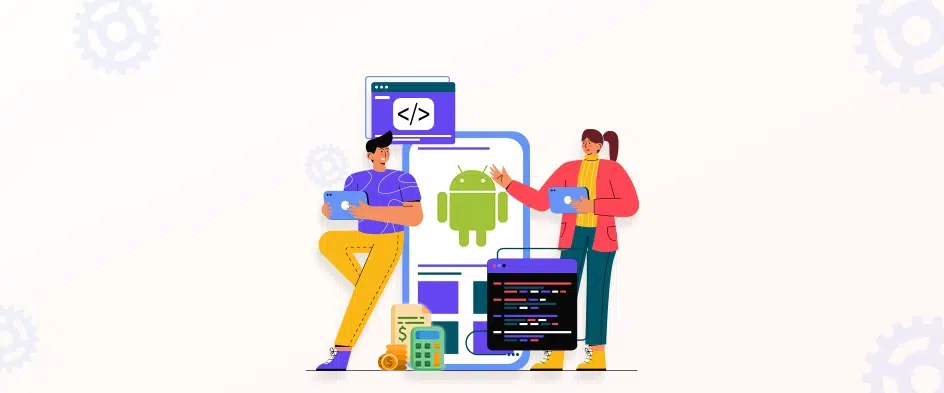Top 10 UX Design Trends That Will Dominate in 2024

- 12 Minutes to read
Table of Content
- What is UX Design?
- Top UX Design Trends
- What is the Impact of UX Design Trends on User Experience?
- Conclusion
- FAQs on UX Design Trends
When it comes to creating websites, web apps, and more, the UX design is quite crucial. Going beyond the aesthetics, it’s about creating an environment where users can effortlessly navigate, engage, and accomplish their goals.
A thoughtfully designed user experience not only enhances user satisfaction but also plays a pivotal role in user retention and conversion rates. It’s the bridge that connects users with the functionality of a website or application, so the journey is not only efficient but also enjoyable. But how do you ensure the best UX design for your product?
Well, that’s where these top UX design trends come in. I’ll tell you all about these trends and how web design companies implement them for the best results. But first let me tell you why UX design matters so much.
What is UX Design?
User Experience (UX) design is a multidisciplinary field that focuses on enhancing the overall experience a user has when interacting with a product, system, or service. The primary goal of UX design is to create products that are easy to use, enjoyable, and provide value to users.
Key aspects of UX design include:
- User Research: Understanding the needs, behaviors, and preferences of the target audience through methods such as surveys, interviews, and usability testing.
- Information Architecture: Organizing and structuring information in a way that is logical and easily navigable for users.
- Wireframing and Prototyping: Creating visual representations (wireframes and prototypes) of the user interface to plan and test the design before implementation.
- Usability: Ensuring that the product is user-friendly and that users can accomplish their goals efficiently and effectively.
- Visual Design: Crafting visually appealing interfaces that align with the brand identity and contribute to a positive overall experience.
- Interaction Design: Defining how users interact with the product, including the responsiveness of elements and the flow of actions.
- Accessibility: Ensuring that the product is accessible to users with disabilities, creating an inclusive experience for all.
- User Testing: Conducting tests with actual users to gather feedback, identify issues, and iterate on the design to improve the user experience continually.
UX design is crucial in a wide range of industries, including web design, app development, software development, and product design. The top web design agencies implement a user-centric approach to create products that not only meet business goals but also resonate with and delight the end users.
Top UX Design Trends
With the digital space changing so rapidly, you have to stay on top of all the latest trends with respect to the different aspects of your product. And when it comes to UX design, there are several trends that can swing the target audience towards your product or software.
So let’s take a look at some of the top ones.
Dark Mode
This design trend involves creating user interfaces with a predominantly dark color scheme, typically using dark backgrounds with light-colored text and UI elements. This design choice is in contrast to the traditional light-themed interfaces that have been more common in digital products.
Here are some key aspects of dark mode in UX design:
- Reduced Eye Strain: One of the primary reasons for the adoption of dark mode is its potential to reduce eye strain, particularly in low-light conditions. Dark backgrounds with lighter text and elements can be gentler on the eyes, especially in the evening or nighttime usage.
- Energy Efficiency (for OLED Screens): Dark mode can contribute to energy efficiency, particularly on devices with OLED (Organic Light-Emitting Diode) screens. OLED displays can turn off individual pixels when displaying black, leading to potential energy savings and improved battery life on devices like smartphones.
- Aesthetic Appeal: Many users find dark mode aesthetically pleasing. The high contrast between dark backgrounds and lighter text or elements can create a visually striking and modern look. It’s often associated with a sleek and sophisticated design.
- Focus on Content: Dark mode can help direct the user’s focus to the content itself. By reducing the prominence of the interface elements and emphasizing the content, dark mode can create a more immersive and distraction-free experience.
- Accessibility: Dark mode can enhance accessibility for users with certain visual impairments or sensitivity to bright light. It provides an alternative color scheme that might be more comfortable for some users.
While dark mode offers several advantages, it’s essential to consider user preferences and the nature of the content when implementing it. Make sure you give your users an option to switch between Dark and Light themes.
Microinteractions
Microinteractions refer to subtle, brief, and often visually engaging animations or responses that occur within a user interface. These small design elements are focused on providing feedback, guiding users, and enhancing the overall user experience. Microinteractions play a crucial role in making interactions with a digital product more intuitive, enjoyable, and responsive.
Here are key aspects to consider when understanding microinteractions in UX design:
- Feedback and Confirmation: Microinteractions are often used to provide immediate feedback to users when they perform an action. For example, a button press might trigger a small animation or color change, confirming that the action was successfully completed.
- Visual Cues: Microinteractions can serve as visual cues that guide users through a process or indicate the status of an element. For instance, a loading spinner or progress bar communicates to the user that a task is in progress. These visual cues contribute to a more transparent and understandable user interface.
- Enhanced Usability: By adding subtle animations or transitions, microinteractions can improve the usability of a product. Smooth transitions between different states or screens can create a more seamless and natural user flow, reducing confusion and frustration.
- Onboarding and Tutorials: Microinteractions are valuable during onboarding processes or tutorials. They can guide users through specific steps, drawing attention to important elements and demonstrating how to interact with the interface.
- Subtle Branding: Microinteractions can contribute to the branding of a product by incorporating consistent visual elements. For example, a unique animation style or sound effect associated with certain actions can reinforce the brand identity.
- Mobile and Touchscreen Interaction: Microinteractions are particularly important in mobile and touchscreen interfaces. The tactile nature of these devices allows for more dynamic and responsive feedback, enhancing the overall user experience.
- Loading Animations: Loading animations are common examples of microinteractions. They provide users with a visual indication that a process is underway, preventing them from feeling uncertain or impatient during short wait times.
- Subtlety and Simplicity: Microinteractions are characterized by their subtlety and simplicity. They should not be overwhelming or distracting but rather seamlessly integrated into the overall user experience.
In summary, microinteractions contribute to the finer details of UX design, making interactions more intuitive, engaging, and user-friendly. The top-rated web design companies leverage these small animations and responses to create a more responsive and enjoyable digital experience for users.
Voice User Interface (VUI)
This trend/technology allows users to interact with a computer, device, or application using spoken language. On traditional graphical user interfaces (GUIs) where users input commands through keyboard and mouse. But VUIs use speech recognition technology to understand and interpret spoken words.
VUIs have become increasingly popular with the rise of virtual assistants and smart speakers.
Here are key aspects to consider when understanding Voice User Interfaces:
- Speech Recognition: The core technology behind VUI is speech recognition. Advanced algorithms analyze spoken words and convert them into machine-readable text. This text is then processed to understand user intent and trigger the appropriate response.
- Natural Language Processing (NLP): Natural Language Processing is a crucial component of VUIs. It enables systems to understand not only individual words but also the context and meaning behind entire sentences. This allows for more natural and conversational interactions between users and the system.
- Virtual Assistants: Virtual assistants, such as Siri, Google Assistant, and Alexa, are popular examples of VUI applications. These platforms use voice commands to perform various tasks, such as setting reminders, answering questions, playing music, and controlling smart home devices.
- Hands-free Interaction: One of the key benefits of VUIs is hands-free interaction. Users can perform tasks and access information without the need to touch a screen or use physical input devices. This is particularly useful in situations where manual interaction may be inconvenient, such as driving or cooking.
- Multimodal Interaction: Some VUI systems also incorporate multimodal interaction, allowing users to combine voice commands with other forms of input, such as touch or gestures. This enhances flexibility and user control.
- Context Awareness: Advanced VUI systems aim to be context-aware, understanding the user’s history of interactions and providing more personalized responses. This contributes to a more seamless and user-centric experience.
VUIs have applications in various domains, including smartphones, smart speakers, smart TVs, and in-car systems. As the technology continues to advance, Voice User Interfaces are likely to play an increasingly significant role in human-computer interaction.
Augmented Reality (AR) and Virtual Reality (VR)
Augmented Reality (AR) and Virtual Reality (VR) are immersive technologies that alter the user’s perception of the real world, each in its own unique way. They are often used to enhance user experiences in various fields, including gaming, education, healthcare, design, and more.
Augmented Reality (AR)
AR enhances the real-world environment by overlaying digital information or virtual elements onto it. Users can still see and interact with the physical world while additional digital content is integrated into their view.
Augmented Reality experiences can be delivered through smartphones, tablets, smart glasses, or dedicated AR devices. Popular examples include Pokémon GO, Snapchat filters, and various AR apps for navigation and shopping.
Virtual Reality (VR)
VR creates a completely immersive, computer-generated environment that users can interact with. In VR, users are isolated from the real world and surrounded by a simulated environment.
VR experiences are typically delivered through head-mounted displays (HMDs) or VR glasses, which may be tethered to a computer or console (PC VR) or operate as standalone devices (mobile VR).
There’s also a concept of Mixed Reality that encompasses both AR and VR. It seamlessly blends digital and physical elements, allowing users to interact with both simultaneously. In mixed reality, virtual objects can interact with and respond to the real-world environment. Examples include Microsoft HoloLens and Magic Leap.
Personalized User Experiences
This trend is all about tailoring the digital experiences to meet the individual needs, preferences, and behaviors of users. The goal is to create a more relevant and engaging interaction by delivering content, features, and design elements that resonate with a specific user or a targeted audience.
Personalization is employed across various digital platforms, including websites, mobile apps, e-commerce platforms, and more.
- Data Collection: Personalization relies on collecting and analyzing user data. This can include demographic information, browsing history, preferences, past interactions, and more.
- User Profiling: Creating user profiles based on collected data helps in understanding individual preferences, behaviors, and patterns.
- Dynamic Content: Websites and apps can dynamically adjust content based on user preferences. This includes personalized recommendations, product suggestions, or relevant articles.
- Adaptive Interfaces: Elements like layouts, colors, and fonts can be adapted to suit individual user preferences.
- Product Recommendations: Recommending products based on a user’s browsing or purchase history.
- Personalized Offers: Providing discounts, promotions, or special offers tailored to the user’s preferences and behaviors.
- Customized User Paths: Personalization involves creating unique user journeys based on past interactions, guiding users through the application or website in a way that aligns with their preferences.
- Behavioral Triggers: Automated responses or suggestions triggered by specific user actions.
- Language Preferences: Adapting the language of the interface based on the user’s location or language settings.
- Regional Content: Offering content that is relevant to a user’s geographical location or cultural background.
- Machine Learning: Leveraging machine learning algorithms to continuously adapt and improve personalization based on user interactions and feedback.
- Predictive Analytics: Anticipating user preferences and needs by analyzing historical data and patterns.
Personalized user experiences aim to enhance user satisfaction, increase engagement, and ultimately contribute to the overall success of digital products or services. But you have to balance personalization with user privacy considerations and ensure that users have control over their data and preferences.
Neomorphism
Neomorphism, also known as soft UI (User Interface), is a design trend that emerged as a modern evolution of skeuomorphism and flat design. Neomorphism combines elements of both styles, aiming to create a user interface that appears soft, tactile, and realistic while maintaining a minimalist and modern aesthetic.
The term “neomorphism” is a blend of “new” and “skeuomorphism.”
Here are key characteristics and considerations related to neomorphism in UI design:
- Soft Shadows and Highlights: Neomorphic interfaces typically feature soft, diffuse shadows and highlights. These elements create a sense of depth and mimic the appearance of objects casting shadows in the real world.
- Minimalistic Design: Neomorphism often embraces a clean and simple design approach, eliminating unnecessary elements to maintain a modern and visually pleasing interface.
- Subtle Color Palette: Neomorphic designs commonly employ a subtle color palette with muted tones and gradients. Soft, pastel colors contribute to the overall gentle and approachable appearance.
- Background and Element Blending: The background color of neomorphic interfaces often blends seamlessly with the color of UI elements, reinforcing the soft and cohesive visual style.
- Realistic Elements: Neomorphism incorporates realistic elements reminiscent of physical materials, such as soft buttons that appear to be slightly raised or depressed.
- Material Mimicry: UI elements may mimic the appearance of materials like plastic, glass, or paper to create a tangible and tactile feel.
- Contrast and Readability: Designers need to carefully consider the contrast between elements to maintain readability. The soft shadows and blending of colors should not compromise the clarity of text and other essential elements.
- Focus on Usability: While aesthetics are essential, neomorphic designs should prioritize usability and ensure that users can easily navigate and interact with the interface.
- Consistency Across Platforms: Ensuring a consistent neomorphic design across various devices and platforms may require careful consideration of each platform’s guidelines and capabilities.
Neomorphism has gained attention for its unique approach to UI design, providing a fresh and visually appealing alternative to flat design and skeuomorphism. As with any design trend, its popularity may evolve over time, and designers often experiment with various styles to create interfaces that align with the preferences of their target audience.
Minimalistic Design
Minimalism is a design approach characterized by simplicity, clarity, and the use of minimal elements to create a clean and uncluttered visual aesthetic. The philosophy behind minimalist design is to focus on the essential elements, eliminating unnecessary details, ornamentation, and distractions.
This design style is prevalent in various creative fields, including art, architecture, and user interface design. Here are key characteristics and considerations related to minimalist design:
- Streamlined Elements: Minimalist design simplifies visual elements to their essential components, avoiding unnecessary embellishments or decorations.
- Clean Lines and Shapes: The use of simple geometric shapes, straight lines, and basic forms contributes to the overall simplicity of minimalist designs.
- Effective Use of Whitespace: Minimalist designs often incorporate ample whitespace (negative space) around elements. This not only enhances visual clarity but also draws attention to the essential content.
- Balanced Composition: The careful distribution of elements within the available space creates a balanced and harmonious composition.
- Neutral Colors: Minimalist designs commonly feature a limited color palette, often leaning towards neutral tones such as white, black, gray, and muted earthy colors.
- Use of Contrast: While the color palette is restrained, designers may use contrast strategically to highlight key elements.
- Simple Fonts: Minimalist designs often utilize clean and simple typefaces. Sans-serif fonts with straightforward lines are commonly chosen for their readability and modern appearance.
- Consistent Typography: Consistency in font choice, size, and spacing contributes to the overall simplicity and coherence of the design.
- Simple Icons: Icons used in minimalist design are typically simple and straightforward, conveying meaning without unnecessary details.
- High-Quality Imagery: When images are used, they are carefully chosen and high in quality. Each image should serve a purpose and contribute to the overall aesthetic.
- Enduring Style: Minimalist design often exhibits a timeless quality. By avoiding trends and excessive ornamentation, minimalist designs can remain visually appealing over time.
Minimalist design has been influential in a wide range of contexts, from architecture and product design to digital interfaces and branding. Its emphasis on simplicity, clarity, and functionality continues to resonate with designers and users alike.
Remember, trends in UX design can evolve rapidly, and it’s crucial to stay informed about the latest developments in the field. Keep an eye on industry publications, attend conferences, and engage with the design community to stay updated on the current trends and best practices.
Or you can look for and choose the best web design company to ensure adherence to the latest trends and tactics for your website or software.
What is the Impact of UX Design Trends on User Experience?
UX design trends can have a significant impact on the overall user experience, shaping how users interact with digital products and influencing their perceptions. Here are some ways in which UX design trends can impact user experience:
- Visual Appeal: Adopting current design trends often leads to visually appealing interfaces. A well-designed and aesthetically pleasing UI can enhance user engagement and create a positive first impression.
- Modern Look and Feel: Trends like flat design, neomorphism, or minimalism contribute to a modern and up-to-date appearance, making users feel that the product is relevant and aligned with contemporary design standards.
- Innovative Navigation Patterns: Emerging trends often introduce new and improved navigation patterns that can enhance usability. For example, the adoption of card-based layouts, hamburger menus, or gestures can impact how users navigate through a website or application.
- User-Centric Design: As trends focus on user needs and preferences, incorporating these design principles can lead to more user-centric products with improved usability.
- Consideration for Diverse Users: Trends like voice user interfaces (VUI) and personalized experiences cater to a broader range of users, including those with different abilities or preferences.
- Integration of New Technologies: UX design trends often align with technological advancements. For example, the adoption of augmented reality (AR) or virtual reality (VR) in design can offer users innovative and immersive experiences.
- Responsive Design: Trends in responsive web design ensure that interfaces adapt seamlessly to various devices and screen sizes, providing a consistent and optimized experience across platforms.
When used thoughtfully and aligned with user needs, these trends can contribute to a positive, engaging, and efficient user experience. However, it’s essential to consider the potential impact on accessibility, usability, and the overall goals of the product or service.
Conclusion
As we explore the impact of UX design trends on user experience, it becomes evident that thoughtful implementation of these trends can result in enhanced aesthetics, improved usability, and increased user engagement.
Some common UX design trends include:
- Dark Mode
- Microinteractions
- Voice User Interface (VUI)
- Augmented Reality (AR) and Virtual Reality (VR)
- Personalized User Experiences
- Neomorphism
- Minimalistic Design
If you need help staying on top of these trends or implementing them in your product or service, our recommendations on the top web design companies would help.
FAQs on UX Design Trends
1. Why should I follow UX design trends?
Following UX design trends allows designers to stay competitive in the industry by adopting best practices and keeping up with user expectations. It helps create modern and intuitive interfaces that improve user satisfaction and drive business success.
2. How can I incorporate UX design trends into my projects?
To incorporate UX design trends, start by researching and analyzing current trends relevant to your target audience. Experiment with new design techniques and tools, conduct user testing to gather feedback, and iterate based on user preferences. Collaborating with other UX designers and staying active in the design community is also beneficial.
3. How can I learn about the latest UX design trends?
Stay updated with UX design trends by following reputable design blogs, attending industry conferences and webinars, joining UX design communities, and exploring design resources and publications. Engage in discussions with fellow designers and participate in online courses or workshops to continuously enhance your knowledge.



